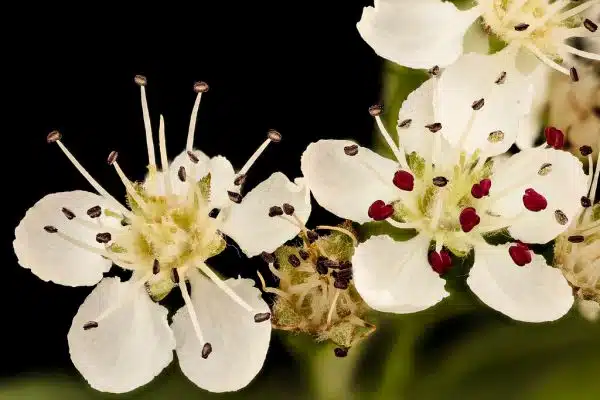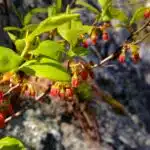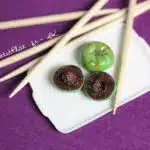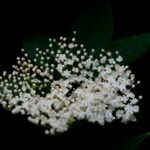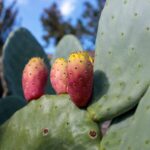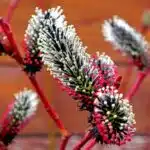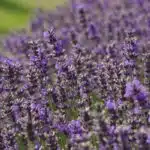The black chokeberry, also known as Aronia melanocarpa, is a deciduous shrub native to North America. It is commonly grown for its striking dark purple berries that are rich in antioxidants and vitamins. The black chokeberry can grow up to 10 feet tall and wide, making it a perfect choice for hedging or as a specimen plant in gardens.
Growing and caring for the black chokeberry may seem daunting at first, but with proper knowledge and techniques, it can be a rewarding experience. In this article, we will explore the essential steps required to grow and care for the black chokeberry successfully. From soil preparation to pruning techniques, we aim to provide you with all the necessary information to help your plants thrive. Whether you’re an experienced horticulturist or a beginner gardener, this guide will equip you with all the knowledge needed to cultivate healthy and productive black chokeberry plants.
Understanding The Black Chokeberry Plant
Black chokeberry, also known as Aronia melanocarpa, is a deciduous shrub that belongs to the Rosaceae family. This plant can grow up to 6 feet tall and wide, and it produces clusters of white or pink flowers in the spring followed by dark purple berries in the fall. The black chokeberry has become increasingly popular due to its many health benefits and ornamental value.
One of the benefits of black chokeberry is its high antioxidant content. According to research, this plant has one of the highest antioxidant levels among all fruits, which makes it an excellent source for preventing chronic diseases such as cancer and heart disease. Additionally, the fruit contains high levels of vitamin C, which helps boost the immune system and improve skin health.
Growing black chokeberry in containers is a great option for those who have limited yard space or want to move their plants around for optimal sunlight exposure. When planting in a container, make sure it is at least 18 inches wide and deep with good drainage holes. Use a well-draining potting mix that contains peat moss or perlite, and water regularly but don’t let the soil get too wet. Prune annually to keep the plant’s size manageable and encourage new growth.
When it comes to growing black chokeberry plants successfully, choosing the right location is crucial. By understanding your plant’s needs and ensuring that they are met through proper sunlight exposure, soil type, watering frequency, pruning techniques, etc., you can create an environment that fosters healthy growth and abundant fruit production.
Choosing The Right Location
As you prepare to plant your black chokeberry, it is important to choose the right location. The ideal spot for this shrub is in a sunny area with well-draining soil that is rich in organic matter. It can also thrive in partially shaded areas, but full shade should be avoided as it can lead to poor fruit production.
When selecting a site for your black chokeberry, keep in mind that it prefers a location with at least six hours of direct sunlight each day. If planting in an area with less sun exposure, ensure that it still receives ample amounts of light throughout the day. Additionally, make sure the soil has good drainage to prevent standing water around the roots.
If planting in a partially shaded area, look for spots that receive morning sunlight and afternoon shade. This will provide the plant with enough light while protecting it from harsh afternoon sun rays. Ultimately, choosing the right location will help ensure that your black chokeberry thrives and produces plentiful fruit for years to come.
As you consider where to plant your black chokeberry, take into account its sunlight and drainage needs. Whether in a sunny or shaded area, make sure the site has good drainage and plenty of light for optimal growth. In the next section, we will explore soil preparation and fertilization techniques to further support your black chokeberry’s development.
Soil Preparation And Fertilization
Soil preparation for black chokeberry should include the addition of organic matter to improve soil drainage and fertility. Fertilization of black chokeberry should include the application of nitrogen, phosphorus, and potassium three to four times a year, as well as micronutrients such as iron, zinc, and magnesium. Soil pH should also be monitored and adjusted to between 4.5 and 5.5 when necessary. Finally, it is important to ensure adequate irrigation to achieve optimal growth and health of the black chokeberry.
Soil Preparation
To ensure the healthy growth of black chokeberry, proper soil preparation is necessary. Before planting, it is important to conduct a soil test to determine the pH level and nutrient composition of the soil. The ideal pH level for black chokeberry ranges from 5.0-6.5. If the soil is too acidic, lime can be added to raise the pH level. On the other hand, if the soil is too alkaline, sulfur can be added to lower it.
In addition to adjusting the pH level of the soil, organic amendments can also be added to improve its quality. Compost and well-rotted manure are excellent sources of organic matter that can enhance soil fertility and structure. They also provide essential nutrients that are vital for plant growth and development. Other organic amendments such as bone meal and fish emulsion can also be used to supplement micronutrients that may be lacking in the soil.
When applying organic amendments, it is important not to overdo it as this could cause nutrient imbalances or even harm the plant. A general rule of thumb is to add no more than 2-3 inches of compost or manure per year. It is also advisable to mix in amendments thoroughly with the topsoil before planting, ensuring an even distribution throughout the root zone. By properly preparing and enriching your soil with organic amendments, you can provide your black chokeberry with a healthy growing environment that will promote optimum growth and fruit production for years to come!
Fertilization
After ensuring proper soil preparation for black chokeberry, the next step is to provide adequate fertilization. Fertilizers are essential for plant growth and development as they provide the necessary nutrients that may be lacking in the soil. There are two types of fertilizers that can be used: organic and synthetic.
Organic fertilizers are derived from natural sources such as compost, manure, bone meal, and fish emulsion. They improve soil fertility by providing essential macronutrients like nitrogen, phosphorus, and potassium which are essential for plant growth. Organic fertilizers also contain micronutrients such as calcium, magnesium, and sulfur which play critical roles in plant metabolism. The main advantage of using organic fertilizers is that they release nutrients slowly over time, ensuring long-term soil health and sustainability.
Synthetic fertilizers, on the other hand, are manufactured chemically using inorganic compounds such as ammonium nitrate, superphosphate, and potassium chloride. They provide a quick boost of nutrients to plants but can have negative effects on soil health if overused. Synthetic fertilizers can lead to nutrient imbalances and soil acidification which can harm plant growth over time. Therefore it is important to use them sparingly and only when necessary.
In conclusion, proper fertilization is crucial for the healthy growth of black chokeberry plants. Organic fertilizers should be preferred over synthetic ones due to their slow-release nature and sustainable benefits. However, it is still important to monitor nutrient levels in the soil and adjust fertilizer application accordingly to avoid any issues with nutrient imbalances or deficiencies.
Planting Techniques
Planting Techniques:
To successfully grow black chokeberry, proper planting techniques must be observed. One of the important considerations in planting is the plant spacing. Black chokeberries should be spaced at least 5 to 8 feet apart to allow enough room for growth and air circulation. This will prevent overcrowding, which can lead to diseases and pests infestations.
Another important aspect of growing black chokeberry is seed starting. It is recommended to start seeds indoors before transplanting them outdoors during the spring season. To start seeds indoors, sow them in a container with moist potting soil and cover them with plastic wrap until they germinate. Once they have sprouted, remove the plastic wrap and place them under grow lights or near a sunny window. After 6-8 weeks, you can transplant the seedlings outdoors.
To ensure successful growth of black chokeberry, careful attention must be given to planting techniques such as plant spacing and seed starting. By following these methods, you can create optimal conditions for your plants to thrive and produce abundant fruit.
Transition into subsequent section:
Proper watering and irrigation are also essential factors in ensuring healthy growth for your black chokeberry plants.
Watering And Irrigation
Black chokeberries need ample irrigation to thrive during the growing season. Drip irrigation is an effective method for supplying consistent moisture to the soil and root system of the plant. Over-watering should be avoided as it can lead to root rot and other fungal diseases. Watering should be done in the morning or evening, when the sun is not at its highest, to minimize the amount of moisture lost to evapotranspiration.
Water Needs
The black chokeberry is a hardy shrub that can withstand drought conditions, making it a great addition to any garden. However, while it has some level of drought tolerance, it still requires regular watering to thrive. When establishing new plants, ensure they receive enough water during the first few weeks until they become established. Afterward, you can reduce watering frequency.
During the growing season, the black chokeberry will require more frequent watering than in other seasons. As a general rule of thumb, water your plants once per week when there is no rainfall or when the soil feels dry to the touch. It is important not to overwater as this could lead to root rot and other fungal diseases that could damage or kill your plants.
It is important to note that the water needs of your black chokeberry may vary depending on its location and soil type. In sandy soils, for example, water tends to drain quickly and may require more frequent watering while clay soils tend to retain moisture longer and may require less frequent watering. Ultimately, monitoring the soil moisture levels and adapting your watering schedule accordingly will help ensure your black chokeberry remains healthy and productive.
Irrigation Methods
Proper watering and irrigation are crucial in maintaining the health and productivity of black chokeberry plants. While regular watering is essential, it is equally important to choose the right irrigation method that will ensure optimal moisture levels for your plants.
One effective irrigation method for black chokeberry plants is drip irrigation. This system involves delivering water directly to the roots of the plant through a network of tubes with emitters placed at specific intervals. Drip irrigation is a highly efficient method as it reduces water loss due to evaporation and runoff. It also allows for precise control of water delivery, ensuring that your plants receive enough moisture without overwatering.
Another option for irrigating black chokeberry plants is through sprinkler systems. This method involves spraying water over the soil surface using sprinklers or nozzles attached to pipes or hoses. Sprinkler systems are advantageous as they can cover large areas, making them ideal for commercial growers or those with extensive gardens. However, it is important to note that this method may not be as efficient as drip irrigation as some water may be lost due to evaporation or wind drift.
In conclusion, choosing the right irrigation method for your black chokeberry plants will depend on various factors such as soil type, climate, and location. Both drip irrigation and sprinkler systems have their advantages and disadvantages, so it’s essential to weigh these carefully before deciding which one to use. Regardless of which method you choose, proper watering and irrigation will help ensure that your black chokeberry plants remain healthy and productive for years to come.
Mulching For Moisture Retention
You may have heard of the saying, “Water is life,” and that’s especially true for plants. But what if I told you that watering your black chokeberry isn’t enough to ensure its growth and survival? That’s right, my dear plant enthusiasts. You need to mulch it up! Mulching is like giving your plant a blanket of protection against harsh weather conditions, pests, and weeds. Plus, it can help retain moisture in the soil.
Organic mulch is a great option for those who want to keep it natural. It’s made up of decomposed leaves, wood chips or bark, grass clippings, and straw. Organic mulch not only retains moisture but also enriches the soil as it breaks down over time. On the other hand, synthetic mulch like plastic or rubber sheeting can also do wonders in terms of moisture retention. However, it doesn’t have the same benefits as organic mulch when it comes to enriching the soil.
When applying mulch around your black chokeberry plants, make sure to spread it evenly around the base of each plant without covering the main stem or trunk. Apply a layer about 2-3 inches thick for best results. Remember that too much mulch can suffocate and damage your plants’ roots! So be careful not to make a mountain out of a molehill.
Mulching helps keep your black chokeberry healthy and happy; now let’s talk about pruning for optimal growth!
Pruning For Optimal Growth
Pruning techniques are essential for the growth optimization of black chokeberry plants. Regular pruning helps to promote healthy plant development and improve the quality of the fruit produced. The best time to prune is during late winter or early spring before new growth appears.
The main objective of pruning is to remove any damaged or diseased branches, along with any dead wood. This helps to prevent the spread of disease and encourages new growth. It’s also important to thin out any overcrowded areas, allowing for better air circulation and light penetration throughout the plant.
Additionally, selective pruning can be used to encourage lateral branching and increase fruit production. This involves removing the terminal bud at the end of a branch, which stimulates the growth of side shoots. Pruning should be done using clean and sharp tools to avoid damaging the plant further. With proper pruning techniques, black chokeberry plants can thrive and produce high-quality fruit for years to come.
Transition: Now that we’ve covered how to optimize growth through pruning techniques, it’s important to know how to deal with pests and diseases that may affect your black chokeberry plants.
Dealing With Pests And Diseases
The black chokeberry plant is a resilient species that can withstand several pests and diseases. However, it is still prone to infestations or attacks from some insects, such as aphids and spider mites, which feed on the plant’s leaves and cause them to wilt. Additionally, fungal diseases such as powdery mildew and rust can affect the plant’s overall health and fruit production.
Integrated pest management (IPM) is a recommended approach for controlling pests and diseases in black chokeberries. This strategy involves preventing or minimizing damage by combining cultural practices with natural remedies. For instance, you can remove affected parts of the plant immediately they show symptoms or use organic pesticides made from botanical extracts such as neem oil or garlic spray. Furthermore, using biological control agents like ladybugs and lacewings helps reduce pests’ population without harming beneficial insects.
Natural remedies are an effective way to control pests and diseases in black chokeberries while maintaining a healthy ecosystem. These remedies include spraying the plants with diluted solutions of baking soda, soap water, or hydrogen peroxide to combat fungal infections. Additionally, planting companion plants such as marigold flowers around your black chokeberry bushes can help repel harmful insects naturally.
As a horticulturalist dedicated to serving others’ needs, it is essential to understand how to deal with pests and diseases in black chokeberries effectively. Integrated pest management strategies combined with natural remedies are the best ways to control these problems without affecting the environment negatively. With proper care and attention, you should be able to keep your plants healthy and productive throughout their lifespan.
Transition: Now that we have explored how to manage pests and diseases in black chokeberries let us move on to harvesting and storing berries for consumption or propagation purposes.
Harvesting And Storing Berries
- Harvesting of black chokeberry should take place during the late summer and early autumn months when the fruit is at its peak ripeness.
- To store black chokeberry, the fruit should be placed in a cool, dry and dark place, such as a refrigerator or pantry, and kept away from direct sunlight.
- The use of protective layers, such as paper towels, can be used to help absorb excess moisture and prevent the berries from sticking together.
- To preserve black chokeberry, the fruit can be frozen, dehydrated, or canned.
- Freezing is the most efficient way to store black chokeberry, as it can be done quickly with minimal flavor loss and texture change.
- Dehydrating and canning are also viable preservation methods and can help to extend the shelf-life of the fruit.
Harvesting Techniques
Black chokeberry is a popular fruit for its many health benefits and culinary uses. When it comes to harvesting, preserving techniques are necessary to ensure the berries’ longevity. The best time to harvest black chokeberries is in the fall when they have fully ripened and turned dark purple or black. Before harvesting, it’s important to inspect the fruit for any signs of disease or pest damage.
To harvest the berries, gently pull them from the stems using your fingers or a small pair of scissors. Avoid pulling too hard as this may cause damage to the plant. Once you have harvested your berries, store them in a cool, dry place or freeze them for later use. Black chokeberries can be used in a variety of culinary applications, including jams, jellies, pies, and sauces.
When it comes to preserving techniques, there are several options available. One method is to freeze the berries whole or puree them and freeze them in ice cube trays for easy portioning. Another option is to dry the berries by laying them out on a baking sheet and placing them in an oven set at 150°F until they are fully dried out. Once dried, the berries can be stored in an airtight container for several months. With proper care and attention during harvesting and storing, black chokeberries can be enjoyed throughout the year in many delicious culinary creations.
Storing Conditions
After harvesting black chokeberries, proper storage is crucial to maintain their freshness and quality. The ideal temperature for storing black chokeberries is between 32°F and 40°F. This temperature range ensures that the berries do not freeze, which can cause damage to the cellular structure of the fruit. Additionally, it’s important to consider humidity levels when storing black chokeberries, as high humidity can lead to mold and spoilage. Therefore, it is recommended to store the berries in a cool, dry, and well-ventilated area.
When storing black chokeberries, it’s important to avoid overcrowding them in containers or bags. Overcrowding can cause bruising and crushing of the berries, leading to spoilage. Instead, arrange the berries in a single layer on a tray or container with adequate space between each berry. This allows for proper air circulation and reduces moisture buildup.
It’s also essential to inspect stored black chokeberries regularly for signs of spoilage or mold growth. If any berries are found to be spoiled or damaged, they should be removed immediately to prevent further contamination. With proper storage conditions and regular inspections, black chokeberries can remain fresh for up to two weeks in the refrigerator and up to six months in the freezer.
Preservation Methods
Berries are a delicious and nutritious addition to any diet. They are a rich source of vitamins, minerals, and antioxidants that support good health. Harvesting and storing berries properly is crucial to preserve their quality and freshness. In this article, we will discuss the preservation methods for berries, specifically freezing and drying.
Freezing is one of the most popular methods of preserving berries. It is an easy process that involves washing the berries thoroughly, patting them dry with a paper towel, and placing them in a freezer-safe container or bag. Berries can be stored in the freezer for up to six months without losing their nutritional value or flavor. Frozen berries can be used in smoothies, baked goods, or eaten as a frozen snack.
Drying is another method of preserving berries that has been used for centuries. Dried berries are a convenient and nutritious snack that can be enjoyed on-the-go. The process involves removing the moisture from the berries by either air-drying or using a dehydrator. Dried berries can be stored in an airtight container for up to six months without spoiling. They can be added to trail mixes, oatmeal, yogurt, or baked goods for added flavor and nutrition.
In summary, freezing and drying are two effective methods of preserving berries for long-term storage. Both methods allow you to enjoy fresh-tasting berries year-round while maintaining their nutritional value. Whether you prefer frozen or dried berries as snacks or ingredients in recipes, these preservation methods provide endless possibilities for incorporating these delicious fruits into your diet.
Propagation Methods
After harvesting black chokeberries, it is important to store them properly to maintain their freshness and flavor. Wash the berries gently in cool water and dry them thoroughly with paper towels or a clean kitchen towel. Place the berries in a single layer on a baking sheet or tray and freeze them until they are solid. Once frozen, transfer the berries to an airtight container or freezer bag and store them in the freezer for up to one year.
For those interested in propagating black chokeberry, there are several techniques that can be used. Air layering is one option where a stem is bent down and buried in soil, allowing roots to form at the bend. Once roots have formed, the new plant can be separated from the parent plant and transplanted elsewhere. Division techniques involve separating existing plants into smaller sections which can then be replanted as individual plants.
Companion planting is an effective method of growing black chokeberries alongside other plants that will benefit each other’s growth. Some recommended companion plants include lavender, thyme, and chives which can help deter pests while also attracting pollinators like bees and butterflies. Other beneficial companions include nitrogen-fixing plants like legumes which help improve soil fertility. By utilizing companion planting techniques, gardeners can create a thriving ecosystem that benefits all of their plants.
Companion Planting
Companion planting is a time-honored gardening practice that involves planting different crops together to create a beneficial relationship. Black chokeberry can be an excellent companion plant, as it offers numerous benefits to other plants in the garden. Understanding the symbiotic relationship between black chokeberry and other plants can help you make the best choices when deciding which crops to plant together.
One of the main benefits of companion planting with black chokeberry is its ability to attract pollinators. The white flowers on black chokeberry bushes bloom in mid-spring, providing a valuable source of nectar for bees, butterflies, and other beneficial insects. These pollinators will then visit nearby crops, helping them produce fruit and seeds more effectively. Additionally, black chokeberry’s dense foliage can provide shade and shelter for other plants that prefer cooler conditions.
When choosing companion plants for black chokeberry, it’s essential to consider their growth habits and nutrient requirements. Some good choices include blueberries, raspberries, and elderberries, which have similar soil preferences and benefit from the same fertilizers as black chokeberry. Other suitable companions include flowering perennials such as asters, goldenrod, and bee balm, which attract even more pollinators to the garden.
Understanding the benefits of companion planting with black chokeberry can help you create a thriving garden ecosystem. By choosing the right companions based on their growth habits and nutrient requirements, you can maximize your harvest while also supporting local pollinator populations. In the next section, we will discuss winter protection strategies that are necessary for ensuring your black chokeberry bushes survive harsh weather conditions.
Winter Protection Strategies
Mulching can be an effective winter protection strategy for black chokeberry, as it helps to insulate the root system and prevent soil heaving. Pruning should be done in late summer or early fall; this helps to reduce the size of the plant and protect it from winter winds and snow. Wrapping black chokeberry plants with burlap or other breathable material can help to further protect them from the winter elements. Additionally, wrapping the plants can help to reduce the amount of moisture lost through transpiration, which is especially important during the winter months. Moreover, wrapping the plants with a winter fabric will also help protect them from the sun’s winter rays, which can dry out the plant quickly. Finally, when wrapping the plant, it is important to secure the material with stakes, so that it does not become dislodged during windy winter days.
Mulching
Mulching is an essential winter protection strategy for black chokeberry plants. It involves covering the soil around the plant with a layer of organic or inorganic material to regulate temperature, retain moisture, and suppress weed growth. This helps to create a conducive environment for the plant to thrive during the cold season.
The benefits of mulching cannot be overstated. Firstly, it helps to keep the soil warm by trapping heat from the sun and preventing it from escaping into the atmosphere. This is especially important in areas with harsh winter conditions where the soil can freeze and damage the roots. Secondly, mulching conserves moisture in the soil by reducing evaporation rates. This ensures that the plant has enough water to survive during periods of drought or low precipitation. Lastly, mulching minimizes weed growth around the plant which would compete for nutrients and water.
When it comes to choosing the best mulching materials for black chokeberry plants, organic materials are highly recommended. These include straw, leaves, pine needles, bark chips, or compost. Inorganic materials like plastic sheeting or rocks may also be used but they do not provide as many benefits as organic materials do. The thickness of the mulch layer should be between 2-4 inches deep to provide adequate protection for the plant.
In conclusion, mulching is an effective winter protection strategy that every black chokeberry grower should consider implementing. The benefits of mulching cannot be overemphasized as it regulates temperature, retains moisture in soil and suppresses weed growth around plants. Organic materials such as straw or bark chips are ideal for this purpose because they provide more benefits than inorganic materials like plastic sheeting or rocks. By following these guidelines on how to grow and care for black chokeberry using winter protection strategies such as mulching, you can ensure that your plants will flourish even during harsh winter conditions.
Pruning
Black chokeberry plants require proper care during winter to ensure their survival and growth. While mulching is an effective strategy, pruning is another essential winter protection method that every grower should consider. Pruning involves removing dead, damaged or diseased branches from the plant to improve its health and structure. This practice also helps to promote new growth in the spring, which leads to a healthier and fuller plant.
When to prune black chokeberry plants largely depends on the specific variety and local climate conditions. Generally speaking, it’s best to prune in late winter or early spring before new growth begins. This timing allows the plant to recover quickly from any damage caused by pruning while also promoting healthy regrowth. The tools used for pruning include hand pruners, loppers or saws depending on the size of branches being removed.
It’s essential to note that excessive pruning can harm the plant’s overall health and production of fruit. Therefore, it’s crucial to have a clear understanding of what needs trimming and how much should be removed. A general rule of thumb is not to remove more than 30% of the plant at any given time. With proper pruning techniques implemented during winter protection strategies, black chokeberry growers can enjoy healthy plants with high fruit yields come harvest season.
Wrapping
Winter wrapping is another effective winter protection strategy that black chokeberry growers can use to safeguard their plants. This technique involves covering the plant with a protective layer to insulate it from harsh weather conditions such as frost, snow, and wind. The primary goal of winter wrapping is to maintain a consistent temperature around the plant, which helps prevent damage caused by extreme temperature fluctuations.
Protective coverings for black chokeberry plants include burlap or geotextile fabrics. These materials are lightweight and breathable, allowing air and moisture to circulate while also providing insulation against the cold. When applying winter wraps, it’s essential to avoid wrapping too tightly as this can cause damage to the branches or even kill the plant. Instead, wrap loosely around the entire plant and secure it in place using stakes or twine.
It’s vital to note that winter wrapping should be used in conjunction with other winter protection strategies such as mulching and pruning. By combining these techniques, black chokeberry growers can give their plants the best chance of surviving harsh winter conditions while also promoting healthy growth in the spring. With proper care and attention during the colder months, black chokeberry plants can thrive year-round and provide a bountiful harvest for years to come.
Common Uses For Black Chokeberries
Like a hidden treasure, the small and dark chokeberries are packed with nutrients that can offer various health benefits. Their versatility in cooking also adds to their appeal, making them a popular choice among culinary enthusiasts. These berries can be used in various recipes, from sweet desserts to savory dishes.
One of the most notable health benefits of black chokeberries is their high antioxidant content. Antioxidants help to protect cells from damage caused by free radicals, which can lead to chronic diseases such as cancer and heart disease. Additionally, chokeberries are rich in vitamins C and K, fiber, and minerals such as iron and potassium.
Culinary versatility is another great aspect of black chokeberries. They can be used in pies, jams, muffins, smoothies, and even sauces for meats or vegetables. With their tart flavor profile similar to cranberries or pomegranates, they add a unique twist to any dish. Their deep purple color also makes them an attractive garnish for cocktails or fruit salads.
Transitioning into the subsequent section about recipes and culinary ideas, there are endless possibilities when it comes to incorporating black chokeberries into your meals. From classic recipes like black chokeberry jam or pie to more experimental dishes like roasted chicken with a chokeberry sauce, these berries offer something for everyone’s palate. Let’s explore some delicious ways to use these versatile little fruits in the kitchen!
Recipes And Culinary Ideas
Black Chokeberry Jam can be prepared using mature fruit that has been harvested in late summer or early fall. The preparation of Black Chokeberry Syrup requires the use of simmering fruit until it reaches a thick syrup consistency. Baked Black Chokeberry Treats can be created by combining the fruit with traditional baking ingredients. Cultivating black chokeberry is best achieved through planting in well-draining, acidic soil and providing adequate sunlight and water throughout the growing season.
Black Chokeberry Jam
The black chokeberry is a versatile fruit that can be used in various culinary applications. One of the most popular ways to enjoy this fruit is by making black chokeberry jam. To start, wash and remove the stems from the berries before crushing them in a pot with a potato masher. Once crushed, add sugar and lemon juice to the pot and let simmer until it reaches the desired consistency. This sweet and tangy jam can be used as a spread on toast or biscuits or as an accompaniment to cheese plates.
Aside from jam, black chokeberries can also be used to make other delicious treats such as wine and syrup. Black chokeberry wine has a deep, rich flavor that pairs well with hearty dishes such as roasted meats or stews. On the other hand, black chokeberry syrup has a sweeter taste that works well when drizzled over pancakes or waffles. Both wine and syrup can be made using similar methods as jam, but with slight variations in ingredients and cooking time.
When caring for black chokeberry plants, it is crucial to ensure they receive adequate sunlight and water. These plants prefer slightly acidic soil with good drainage. Pruning should be done annually during late winter or early spring to promote healthy growth and fruit production. With proper care, black chokeberries can thrive for many years, providing both beauty and delicious fruit for any home garden or orchard.
Black Chokeberry Syrup
Black chokeberries are a versatile fruit that can be used in various culinary applications. One of the most popular ways to enjoy this fruit is by making homemade preserves such as jams, wines, and syrups. While black chokeberry jam offers a sweet and tangy flavor that works well as a spread or an accompaniment to cheese plates, black chokeberry syrup has a sweeter taste that pairs well with breakfast favorites like pancakes or waffles.
To make black chokeberry syrup, start by washing and removing the stems from the berries before crushing them in a pot with a potato masher. Once crushed, add sugar and water to the pot and let simmer until it reaches the desired consistency. The resulting syrup can be stored in sterilized jars for future use or served immediately with your favorite breakfast dish.
Black chokeberry juice is also an essential ingredient when making this syrup. This juice can be made using similar methods as jam but with slight variations in ingredients and cooking time. To get started, crush black chokeberries in a pot and add water before boiling for 15 minutes. Once boiled, strain the mixture through cheesecloth to remove any solids before adding sugar and letting it simmer until it thickens into a syrupy consistency. With its sweet taste and unique flavor profile, black chokeberry syrup is an excellent addition to any home cook’s kitchen repertoire.
Frequently Asked Questions (Faqs
Transition: Now that we have explored some recipes and culinary ideas for black chokeberry, let us dive into the horticultural aspect of growing and caring for this plant.
Black chokeberry can be propagated through seeds or cuttings. The best time to harvest seeds is during fall when the berries are ripe. It is important to stratify these seeds in a moist medium for at least three months before planting them in early spring. Cuttings can be taken from mature stems during late winter or early spring, treating them with rooting hormones before planting.
Seasonal care is crucial for the optimal growth and development of black chokeberry. During the growing season, it is important to keep the soil consistently moist but not waterlogged. Regular pruning helps maintain its shape and promote new growth. In winter, it is necessary to protect the plant from harsh winds and frost by covering it with burlap or other protective materials.
In summary, propagation techniques such as seed stratification and stem cuttings are essential in cultivating new black chokeberry plants. Seasonal care involves keeping the soil moist, regular pruning, and protecting the plant during winter. With proper care, your black chokeberry plant will flourish and provide you with a bountiful harvest of delicious berries year after year.
Frequently Asked Questions
Can Black Chokeberry Be Grown In Containers?
For those seeking to exercise their green thumb through container gardening, black chokeberry is a viable option. However, it is important to note that container gardening requires specific soil requirements in order for the plant to thrive. As a horticulturalist, I recommend using well-draining soil with a pH level of 5.5-6.5 and incorporating organic matter such as compost or peat moss. Additionally, it is crucial to ensure proper drainage within the container through the use of drainage holes or rocks at the bottom of the pot. With these considerations in mind, successfully growing black chokeberry in containers can be a fulfilling and rewarding experience for those with an inclination towards serving others through gardening.
How Long Does It Take For Black Chokeberry To Reach Maturity And Produce Fruit?
Black chokeberry propagation can be achieved through the use of cuttings, which should be taken from healthy plants during the dormant season. Optimal planting conditions include well-drained soil with a pH level between 3.5 and 5.5, as well as full sun exposure. It takes about two to three years for black chokeberry bushes to reach maturity and produce fruit, although this time frame can vary depending on factors such as soil quality and climate conditions. Once mature, black chokeberries typically yield an abundant harvest that is rich in antioxidants and other beneficial nutrients. As a horticulturist, it is important to recognize the potential benefits of growing black chokeberries and to provide guidance on how best to cultivate these valuable plants for those seeking to serve others through their gardening efforts.
What Is The Best Time Of Year To Harvest Black Chokeberries?
The best time to harvest black chokeberries is in late summer or early fall, when the fruit turns a deep purple-black color and has a slightly wrinkled appearance. To ensure optimal harvesting techniques, it is recommended to pick the berries by hand and avoid using machinery that may damage the plant or fruit. Preservation methods for black chokeberries include freezing, canning, or making jams and jellies. The fruit’s high level of antioxidants and nutritional value makes it a popular choice for those seeking health benefits from their food choices. As horticulturalists, it is our duty to provide accurate information on proper harvesting techniques and preservation methods to ensure that our audience can fully enjoy the benefits of this versatile plant.
How Do You Know When Black Chokeberries Are Ripe And Ready To Be Picked?
Black chokeberries are typically ready for harvest in late August to early September, depending on the region and weather conditions. The berries should be fully ripe and have a dark purple to black color, with a slight softness when gently squeezed. Harvesting techniques include gently pulling the berries off of the stem or using a rake-like tool to collect them from the shrub. It is important to avoid picking unripe or overripe berries as they may not have the desired flavor or texture. Once harvested, black chokeberries can be used in various culinary ways such as making jams, jellies, sauces, and baked goods.
Can Black Chokeberries Be Frozen Or Canned For Later Use?
The question of whether to freeze or can black chokeberries for later use is a bit like choosing between two different paths in a garden. Each option has its own benefits and drawbacks, much like the choice between a meandering walkway and a straight one. Freezing chokeberries preserves their flavor and nutritional content well, but can make them soft and mushy upon thawing. Canning, on the other hand, allows for more versatility in recipes and longer storage times, but may reduce some of the berry’s health benefits due to cooking. Ultimately, the decision comes down to personal preference and intended use. For those seeking inspiration for chokeberry recipes, there are countless options available from pies to jams to savory sauces. As horticulturalists, it is our duty to not only cultivate these plants but also provide guidance on how best to utilize their bounty for the benefit of others.
Conclusion
Black chokeberry is a versatile and hardy shrub that can be grown in many different types of soil and environments. While it is primarily known for its nutritious berries, the plant also has ornamental qualities that make it a popular choice for landscaping. Growing black chokeberry requires minimal effort and attention, making it an ideal choice for those who are new to gardening.
One of the most important aspects of caring for black chokeberry is ensuring that it receives enough sunlight and water. It is also important to prune the plant regularly to keep it healthy and prevent overcrowding. With proper care, black chokeberry can produce bountiful crops of delicious fruit year after year.
As horticulturalists, we are constantly seeking out plants that are both beautiful and functional, and black chokeberry fits the bill perfectly. With its striking dark foliage and bright red berries, this shrub is sure to make a statement in any garden or landscape. So why not give it a try? Whether you’re looking to add some color to your yard or simply want to enjoy the health benefits of these tasty berries, black chokeberry is definitely worth considering. As the old saying goes, “A garden without diversity is like a canvas without color.”
Image Credits
- “Aronia melanocarpa, Black Chokeberry 2, Howard County, Md., _2018-05-17-14.16” by Sam Droege (featured)

